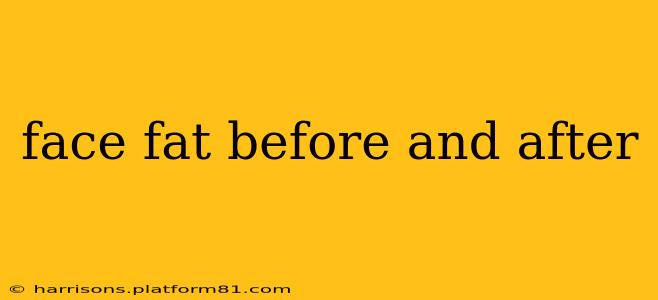Facial fat distribution is a common concern, with many individuals seeking ways to reduce it for a more defined look. This can be influenced by various factors, including genetics, weight fluctuations, and aging. Understanding the changes involved and the options available is key to making informed decisions about your facial appearance. This comprehensive guide explores the before-and-after transformations associated with face fat reduction and the methods used to achieve them.
What Causes Facial Fat?
Before diving into before-and-after results, it's crucial to understand the root causes of facial fat. Several factors contribute to its accumulation:
- Genetics: Your genetic predisposition plays a significant role in where your body stores fat, including your face. Some individuals are naturally prone to more facial fat than others.
- Weight Fluctuations: Weight gain, even a modest amount, can lead to increased fat deposits in the face. Conversely, weight loss often results in a reduction of facial fat.
- Aging: As we age, our skin loses elasticity, and the underlying fat pads in our face can shift and become more prominent, contributing to a fuller appearance.
- Hormonal Changes: Fluctuations in hormones, such as during pregnancy or menopause, can also influence facial fat distribution.
- Lifestyle Factors: Poor diet, lack of exercise, and excessive alcohol consumption can contribute to overall weight gain and, consequently, increased facial fat.
Face Fat Before and After: Dramatic Transformations?
The degree of change you see in before-and-after photos depends on several factors, including your starting point, the method used for reduction, and individual responses to treatment. While some individuals experience subtle changes, others may see more dramatic results. Realistic expectations are crucial. No treatment guarantees a specific outcome, and results vary.
How to Reduce Face Fat: A Multifaceted Approach
There's no single "magic bullet" for reducing face fat. A comprehensive approach typically involves a combination of strategies:
1. Weight Loss Through Diet and Exercise
This is often the most effective and sustainable method. Losing overall body fat usually results in a reduction of facial fat. Focus on a balanced diet rich in fruits, vegetables, and lean protein, combined with regular cardiovascular exercise and strength training.
2. Non-Surgical Procedures
Several non-surgical options can target facial fat:
- Facial Massage: Certain massage techniques may help to improve circulation and lymphatic drainage, potentially reducing puffiness and improving facial contours.
- Liposuction: Although traditionally used for larger areas, newer techniques allow for targeted fat removal from smaller areas like the face.
3. Surgical Procedures
For more significant or stubborn facial fat, surgical options may be considered:
- Buccal Fat Removal: This surgical procedure involves removing buccal fat pads, which are located in the cheeks. It results in a more sculpted and defined facial appearance.
What to Expect After Treatment?
The recovery period and aftercare instructions vary depending on the chosen method. Non-surgical procedures generally have minimal downtime, while surgical procedures require a longer recovery time with potential swelling and bruising. Always follow your doctor's instructions carefully.
Frequently Asked Questions (Addressing PAA Queries)
Here, we will address common questions found in the "People Also Ask" section of search engines, ensuring comprehensive coverage of this topic. (Note: Specific PAA questions will vary based on search engine and current trends. The following are examples of frequently asked questions related to face fat reduction.)
How can I lose face fat quickly? While rapid weight loss might seem appealing, it's generally unsustainable and can be detrimental to overall health. A gradual, healthy approach to weight loss through diet and exercise is more effective and safer in the long run for reducing facial fat.
Does drinking water reduce face fat? Staying adequately hydrated is crucial for overall health. While water doesn't directly burn fat, it can help reduce water retention, which might contribute to a slightly less puffy appearance.
Can you get rid of face fat with exercise? Targeted facial exercises alone are unlikely to significantly reduce facial fat. However, regular exercise, particularly cardiovascular workouts, helps with overall weight loss, which indirectly reduces face fat.
What are the risks of face fat removal surgery? As with any surgical procedure, buccal fat removal carries risks, including infection, bleeding, and nerve damage. A thorough consultation with a qualified surgeon is essential to assess your suitability and understand the potential risks and benefits.
Conclusion:
Reducing face fat requires a holistic approach that considers individual factors and realistic expectations. A combination of lifestyle changes, non-surgical treatments, and, in some cases, surgical procedures can contribute to a more defined facial appearance. Always consult with a healthcare professional or a qualified dermatologist or plastic surgeon to determine the best course of action for your specific needs and to ensure safe and effective treatment. Remember, the journey to a more sculpted look is often a process, requiring patience and commitment.
